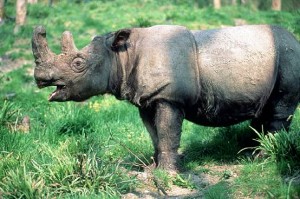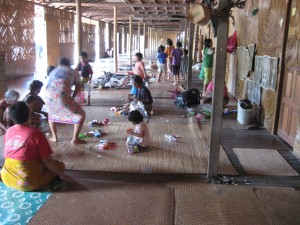by Wong Ho Leng
 On 15 June, 2012, the Malaysian government signed an Agreement with the China Wildlife Conservation Association (CWCA) which will pave the way for the loan of two giant pandas to Malaysia for a period of 10 years.
On 15 June, 2012, the Malaysian government signed an Agreement with the China Wildlife Conservation Association (CWCA) which will pave the way for the loan of two giant pandas to Malaysia for a period of 10 years.
The panda loan will commemorate the 40th anniversary of Malaysia-China diplomatic relations in 2014.
The affable pandas are the iconic treasures of China. They live in the temperate-zone bamboo forests in central China. They are the best recognised but one of the rarest animals in the world and symbolise endangered species and conservation efforts.
The Malaysian Prime Minister said that the presence of pandas in Malaysia will boost the tourism industry for the country.
The real cost
Some greeted the panda-loan with rousing merriment. Others have reservations. We don’t know as yet the actual costs to Malaysian taxpayers, but there are good references for known costs from similar arrangements with other countries, notably from the USA and Singapore:
|
No. |
Description |
Total Costs (10 years) |
| 1. | The loan fees: US$1 million (RM3.1million) per year | RM31 million |
| 2. | Research and Conservation fees: US$1million (RM3.1 million) per year | RM31million. |
| 3. | Enclosure, air conditioned artificial habitat at Wetland Park at Putrajaya (The temperature has to be kept at between 18 and 22 degrees, and humidity at between 50%-60%) | RM20 million |
| 4. | Maintenance and upkeep RM1 million per year | RM10 million |
| 5. | A new place for planting panda’s dietary food – bamboo. A panda consumes about 40 kg of bamboo each day | RM10 million |
| 6. | In the event cubs are born, an additional loan fee of US$600,000 per year (cubs will be returned to China after the 2nd year) | Unknown |
The loan scheme gives the impression that the Malaysian Government has a deep pocket. But had Malaysians been appraised with these known costs (in excess of RM100 million), it is possible that those who had greeted the news with enthusiasm initially will change their mind.
Nine pandas are on loan from China in four zoos in the U.S.A. Between 2000 and 2003, the income from admissions were unable to meet expenses. A deficit of US$33 million was suffered.
Our country is heavily in debt. Apart from budget deficits which had embarrassed us for 15 years, our national debt is hovering around the RM470 billion mark. Each Malaysian, young or old, carries a debt of RM16,000 on his/her shoulders.
We are not against animal research and conservation efforts. However, what use is it to conduct panda conservation research, including in the areas of artificial insemination and behaviour studies, when Malaysia does not offer the natural habitat?
The money for the pandas should be utilised for the conservation of local endangered wildlife species.
Wrong Priorities, Wrong habitat?
 In its obsession and adulation toward the non-native but iconic treasure of China, the Malaysian Government conveniently ignores our own animal treasure troves such as the Malayan Sun bear, Malayan tiger, marine turtles, orang-utans and Sumatran rhinoceros.
In its obsession and adulation toward the non-native but iconic treasure of China, the Malaysian Government conveniently ignores our own animal treasure troves such as the Malayan Sun bear, Malayan tiger, marine turtles, orang-utans and Sumatran rhinoceros.
About 1,600 pandas are estimated to live in the wild. But Asia’s only great ape the orang-utans, are facing extinction too. There are a mere 1,300 orang-utans in Sarawak, all in the Lanjak-Entimau Wildlife Sanctuary and Batang Ai National Park.
They are the largest tree dwelling mammal in the world. Scientists have predicted that by 2020, less than 10-15 percent of Borneo’s total orang-utan population will survive.
The reasons for the decline include poaching, habitat loss which had given way to plantations, and lack of political will to enforce legislation that protects the species.
Malaysia does not have an impeccable record of animal conservation. The humongous sums to be spent on the two pandas can be spent on saving our own endangered species.
Education, law enforcement against poaching, restoring the animal habitat and reforestation are priorities. Trafficking of protected wildlife is rampant in Malaysia, and Sarawak is no exception, no thanks to lack of enforcement, and the national poison called corruption.
We have the empuraus of Sarawak, the most expensive fresh water fish in the world. They can grow over 10 kg in weight and fetch up to RM1,000 per kg. They used to be aplenty in the pure fresh waters of the upper reaches of the Rejang River in the central region of Sarawak.
Do we have sizeable 1000 empuraus in our rivers now? Their habitat has been destroyed by uncontrolled logging which causes soil erosion to contaminate the fresh water.
The logging was so excessive that on 7 and 8 October, 2010 about 300,000 metric tonnes of timber logs, stumps and debris flowed down from the upper stream of Rejang River to Sibu, causing logjam, ecological disaster and massive environmental damages along the way.
The debris clogged the river so much that lots of fish were suffocated and were seen floating on the rivers. These include empuraus from the upper reaches.
The environmental catastrophe “benefited” the native fishermen for two days when they picked up the fish from the river. But they too, are the poorest people in Sarawak. As of 11 June, 2011, there are 27,902 hard core poor families in Sarawak.
The breakdown is as follows: Iban, 13,349 (47.8 percent), Malays, 5,601 (20 percent), Orang Ulu, 2,925 (10.5 percent), Bidayuh, 2,757 (9.8 percent), Melanau, 1,974. That is to say, among the bumiputera communities, 95.2 percent of the poor families are categorized as hard core poor. For the Chinese, it is 674 (2.4 percent) and for others 622 (2.2 percent).
Sarawak native deserves better
 In 1963, Sarawak joined to form Malaysia, not as an individual state but as an equal partner, but the equal partnership sounded hollow since day one. The federal government has been marginalising Sarawak. Today, Sarawak is at least 20 years behind West Malaysia.
In 1963, Sarawak joined to form Malaysia, not as an individual state but as an equal partner, but the equal partnership sounded hollow since day one. The federal government has been marginalising Sarawak. Today, Sarawak is at least 20 years behind West Malaysia.
After 49 years in the bosom of the federation, Sarawak does not even have a highway. Our pride is the Pan-Borneo Trunk Road which has become so notorious for accidents that Sarawakians call it the Trunk Road to Hell.
There are more than 5,000 longhouses in Sarawak. The majority of them are in dilapidated condition. They do not have water and electricity supply. There are little infrastructure and roads serving them.
Some native children have to wake at four am and walk for three hours through jungle tracks to school. Education is an investment into the future, but has the Government been so proactive to cater the education needs of these natives? Shouldn’t the people be first priorities instead of pandas? -The Rocket




BN Najib can be less bunga or not? Others do what, they also follow. LIke kanak kanak